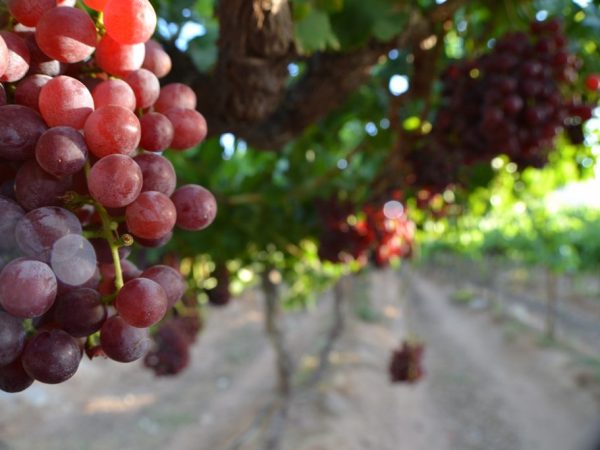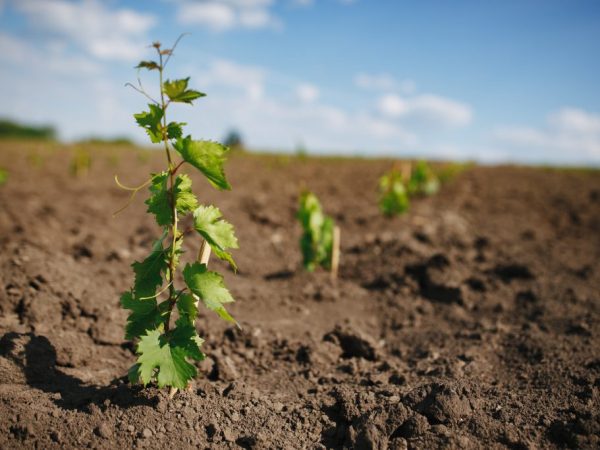Description of Dunav grapes
The Dunav grape is a complex hybrid created by Matevskaya and Kondarev in 1966. The birthplace of the berry is Bulgaria. This variety is also called the Miracle of Bulgaria. The plant is resistant to cold weather, withstands temperatures down to -21 ° C.

Description of Dunav grapes
Description of the variety
Dunav grape variety - early table, ripening period - up to 125 days. Gardeners note the high yield of this species - more than 30 kg can be harvested from one bush. Each shoot forms 1 - 2 bunches. The crop is harvested 2 times a year;
According to the description, fruiting shoots make up 65%. The berries are easily transported, the wasps do not spoil the harvest. The Danube does not require third-party pollination, as there are bisexual flowers on the bushes. The plant is vigorous, the clusters are large.
Description of berries
Dunav berries are large, red, purple in color. The shape is elongated, in the form of a cone. According to the description, the approximate size of the berries is 2-3 cm and the weight is up to 8 grams.
Taste qualities
The sugar content of the variety is about 20%, which is a low indicator. It is well used for eating, as well as for making juice and wine. Has a pronounced aroma.
The very inside of the berry is dense. The grapes are juicy and crispy.
Main pluses:
- berries do not crack;
- doctors advise to use for diabetes mellitus;
- the clusters are even;
- berries do not fall off the bush.
Planting and leaving
Residents of the North and Center of Russia are not advised to grow this species, since it will be difficult to take root in their regions of the Danube. This species loves high humidity, but does not tolerate heavy rainfall.
Landing

Planting is best done by cuttings.
Planting is most effective with cuttings, which should have at least 4 buds. The seedlings are placed in a container with water, after a few days, after which they are planted in small containers. Gardeners use this method in the spring. The length of the cutting should be about 0.5 m, the thickness - 1 cm. After cutting, they are placed in water for 24 hours, after which they are covered with paraffin and placed in bags. Such blanks are stored in special places where the air temperature is from 0-7 ° C, for a period of at least 3 months.
Care
Care includes:
- top dressing;
- watering;
- mulching;
- pruning;
- styling for the winter.
In order for the plant to have a healthy appearance and a pronounced taste, it is systematically fertilized. Gardeners advise adding potassium and phosphorus to the soil. It is good to feed with superphosphate, or urea solution. These procedures are carried out simultaneously with watering. Watering should be abundant and frequent.
Dunav needs a lot of sunlight.
As soon as the first shoots appear, the top layer of soil is removed. With this procedure, the plant is hardened, and it is easier to follow the root system. The upper processes of the root are also removed, due to which the root system grows deeper into the ground. This will help the plant to feed on groundwater, and in winter it will be easier to overcome frost.
It is worth taking special attention to the preparation for the wintering of the plant. The bushes must be properly and well preserved in order to bear fruit for the next season.Before covering the grapes, you need to remove the vines from the supports, then collect them in a heap and attach. Gardeners are advised to put insulating materials on the ground so that the plant does not freeze. On top of the Dunav it is worth putting dry leaves or loose earth.
After wintering, at the beginning of spring, the Danube is opened, cut off and attached to the trellis. The soil is fertilized and loosened. Shoots are tied up depending on its growth.
Harvest
The berries on the Dunav bushes can stay for a long period, while changing their color. The harvest does not lose its taste, but on the contrary, the taste becomes more intense.
Harvested in mid-August, grapes bears fruit until mid-September. Stores well in cool places.
Diseases and pests
According to the description, Dunav is prone to fungal diseases. The fungus appears after cold air temperatures, as well as heavy rainfall.
For prophylaxis, the plant is sprayed with Ridomil and Oksikhom. Any product that contains copper will do. Spraying should be carried out systematically (every few months) to completely get rid of the fungus.
Common diseases:
- black spot - on the bark and foliage, swellings, dark, sometimes brown, will be found. Most often, the disease manifests itself in early summer;
- gray rot - found on young plants, it can manifest itself all year round;
- anthracnose is a fungus that damages the entire plant (from shoots to berries).
Conclusion
Dunav grapes are a table and early variety. Fruiting in mid-August, the berries stay on the bushes for a long time, do not crumble. It is resistant to cold weather, requires careful watering and a lot of sunlight. Vulnerable to fungal diseases, spraying is systematically required. Used well for sales.


